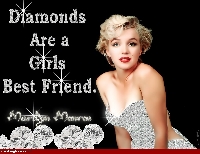Why diamonds?
By Catalogs Editorial Staff

Why diamonds? Why not!
Why diamonds? What kind of question is that? Why not diamonds!?
Not every woman or man is desirous of being covered with diamonds from head to toe but most aren?t adverse to a diamond ring (or two), particularly when it comes to the ring finger on the left hand.
Diamonds are forever.
Diamonds are a girl?s best friend.
Diamonds are a good investment. The value will appreciate over time. The price of diamonds can remained steadfast over the years and hasn?t declined as have other commodities.
Diamonds are beautiful. They sparkle.
Although there are other stones that are arguably just as pretty, diamonds – both real and simulated – hold a special place in the hearts of many men and women. Diamonds have long been equated with glamour, status and wealth and are, in fact, the most popular stone when it comes to engagement rings and every other kind of jewelry.
Now, of course, not everyone can afford a diamond. Instead of “Why diamonds?” they can quickly answer “Why not diamonds?”Or they can afford a small stone, but love the glamour and sparkle of a larger diamond. Many people prefer to purchase sparkle that is more economical and spend the larger chunk of their savings on a downpayment, automobile or college tuition. People who are concerned about diamond mining and political issues often also prefer simulated diamonds. Don’t be embarrassed. You are in good company. You can purchase a simulated diamond and no one will ever know otherwise.
A simulated diamond is created through technological processes and has properties that are similar to those found in authentic diamonds. Some refer to simulated diamonds as lab-created diamonds. You still get the beauty of a diamond; you just aren’t going to bankrupt yourself in the process.
Diamonds are considered timeless, whether they?re in a ring, necklace, earrings, bracelet, wristwatch, cufflinks or brooch. Diamonds can be understated or bold and come in various styles and shapes.
~
Diamonds popped up on the scene, in India, 3,000 years ago. They were worn as a talisman to ward off evil and to afford the wearer protection when engaging in battle. Diamonds were considered valuable, back then, because they had the ability to refract light.
During the Dark Ages, it was believed that diamonds had medicinal benefits. If a diamond was held in the hand while genuflecting this would cure sickness and heal wounds. Some people even ate diamonds in hopes that it would cure them of whatever ailed them.
During the Middle Ages, diamonds weren?t coveted so much for their healing powers as they were for their worth. In fact, diamonds became so sought after that the men who owned mines spread a rumor that diamonds were poisonous. They did this so that the miners wouldn?t swallow the diamonds in an attempt to smuggle them out of the mines.
In the Middle Ages, the Blue Hope diamond and the Koh-I-Noor diamond were discovered in India and diamonds subsequently became more popular than ever.
If you are in the market for a diamond or simulated diamond, there are some things you should know. The price of a real diamond is based in the Four C?s: Cut, color, clarity and carat weight. The cut of the diamond, when done correctly, allows light to be reflected from one facet to another after which the light is dispersed through the top of the diamond. If the diamond is cut too deeply, light can escape through the opposite side of the pavilion (which is a part of the diamond) and if the cut is too short, light is able to escape through the pavilion before the light can be reflected. The price of a simulated diamond is based upon similar criteria, with the weight and setting being most important.
The cut of the diamond is not the same as the shape of the diamond. The most in demand shapes for diamonds include pear, round, oval, heart, marquise and emerald.
Diamonds range in color from pink, to brown, faint yellow, greens, blues and ?fancies,? which are other colors. Colorless, or white, is the best color because light passes through the diamond effortlessly and the light is spread throughout the ring resulting in a rainbow effect.
To determine the clarity of a diamond a magnifying class is used by a jeweler. Diamonds, or at least most of them, have inclusions which are tiny impurities that can interfere with light transference. The fewer inclusions there are the prettier the diamond is.
Popular Savings Offers
The weight of a diamond is measured in carats, which are divided into 100 points.











